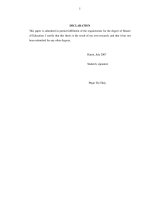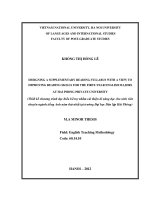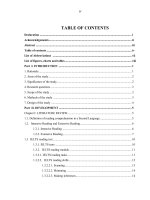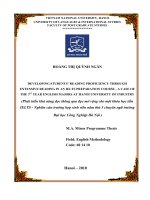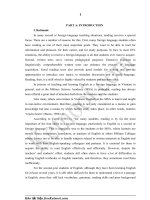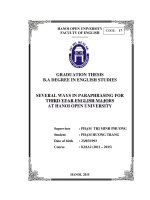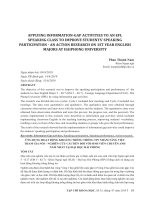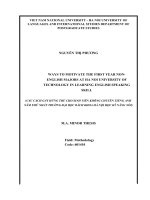Developing students' reading proficiency through extensive reading in an IELTS prepation course - A case of the 3rd year English majors at Hanoi University of I
Bạn đang xem bản rút gọn của tài liệu. Xem và tải ngay bản đầy đủ của tài liệu tại đây (1.15 MB, 67 trang )
iv
TABLE OF CONTENTS
Declaration i
Acknowledgements ii
Abstract iii
Table of contents iv
List of Abbreviations vii
List of figures, charts and tables viii
Part I. INTRODUCTION 1
1. Rationale 1
2. Aims of the study 2
3. Significance of the study 2
4. Research questions 3
5. Scope of the study 3
6. Methods of the study 3
7. Design of the study 4
Part II. DEVELOPMENT 5
Chapter I: LITERATURE REVIEW 5
1.1. Definition of reading comprehension in a Second Language 5
1.2. Intensive Reading and Extensive Reading 6
1.2.1. Intensive Reading 6
1.2.2. Extensive Reading 7
1.3 IELTS reading test 10
1.3.1. IELTS tests 10
1.3.2. IELTS reading module 11
1.3.2.1. IELTS reading tasks 11
1.3.2.2. IELTS reading skills 12
1.3.2.2.1. Scanning 13
1.3.2.2.2. Skimming 14
1.3.2.2.3. Making inferences 14
v
1.4. Extensive Reading and IELTS reading test 15
1.5. Reading Proficiency 16
Chapter II: METHODOLOGY 17
2.1. Rationale for using experimental method 17
2.2. Variables 17
2.3. Participants 17
2.4. Pretest and Posttest……………………………………………… 18
2.5. The extensive reading program…………………………………………………… 19
2.5.1. Reading materials…………………………………………………… 20
2.5.2. Syllabus and activities…………………………………………………… 21
2.6. Procedures……………………………………………………………………… 24
Chapter III: FINDINGS…………………………………………………………… 25
3.1. Comparison of experimental and control groups’ reading proficiency after the extensive
reading program…………………………………………………… 25
3.1.1. The results of experimental and control groups in the pre-test and post – test 25
3.1.2. Mean gains of experimental and control groups … ………… 26
3.2. Surveyed students’ opinions on extensive reading for pre-IELTS course 27
3.2.1 The students’ difficulties in reading IELTS reading texts 27
3.2.2. Experimental subjects’ attitudes towards extensive reading in the pre-IELTS
course 28
3.2.3. Students’ suggestions for the extensive reading in pre-IELTS course 29
Chapter IV: IMPLICATIONS 31
4.1. Research implications 31
4.2. Suggestions on the implementation of extensive reading in pre-IELTS class 32
4.2.1. Grouping and instructing 33
4.2.2. Preparations and Presentation procedures…………………………… 35
Part III. CONCLUSIONS 37
1. Conclusions 37
vi
2. Limitations of the study 37
3. Recommendation for further research 38
REFERENCES 39
APPENDICES I
Appendix 1: The pretest I
Appendix 2: The post test………………………………………………………………… VIII
Appendix 3: Answer to the pretest and Answer to the posttest………………… …… XIV
Appendix 4: The students’ results in the pre-test, post – test and gain….………………….XV
Appendix 5: The post- program questionnaire………………………………………… XVI
Appendix 5: Sample Reading………………………………………………………… …XVII
Appendix 6: Sample
Report… ……………………………………………………… XVIII
Appendix 7: Sample Reflection………………………………………………… ……… XIX
vii
LIST OF ABBREVIATIONS
HaUI: Hanoi University of Industry
IELTS:International English Language Testing System
ER Extensive Reading
ERP Extensive Reading Program
L2: Second Language
M Mean
SD Standard deviation
N: Number of cases
df: Degree of freedom
t: Obtained value
p: Probability
viii
LIST OF TABLES
Tables:
Table 1: Question types and reading skills in the pretest and posttest
Table 2: Topics for The extensive reading program
Table 3: An overview of the extensive reading program for third year English majors at
HaUI
Table 4: Descriptive statistics for the pre-test and post-test scores of experimental and
control groups.
Table 5: Mean gains of experimental and control groups.
Table 6: Experimental students’ difficulties in reading IELTS reading texts
Table 7: Experimental students’ attitudes to extensive reading in the pre-IELTS course
Table 8: Students’ suggestions for the extensive reading in pre-IELTS course
1
Part I – INTRODUCTION
1.Rationale
There is a number of reasons why we read and this will often influence what we read and
how we read it. We might read for pleasure, some may read for information update while
others do for reading skill enhancement. In other words, there might be multiple reasons
why someone might read a text. But working out the purpose is a key factor when it comes
to teaching reading.
From the point of view of reading teachers for English majors, we ourselves are fully
aware of the essential role that reading plays in the students‟ performances as well as
objectives they necessarily set for the subject. It is generally believed that reading has been
considered as a skill which helps students to enhance their vocabulary, their knowledge of
phonetics, grammar, pragmatics, it is also a very effective means of providing real life
information to students. Nonetheless, there is now a great deal of evidence that if students
wish to master their reading and meet the requirements of the work when they finish their
university, they are expected to become the experts of reading strategies, who know which
one is suitable to explore a certain type of reading text. As well, it would be very important
that they know how to find reading sources to open their mind in exotic fields, how to self
work and, by no means less essentially, to co-work with their friends to be engaged in
problem solving given in the reading texts. Equally important, students are thought to
make presentation to express their critical thinking to share with their friends after reading
the texts.
As a matter of fact, there is little doubt that in case students want to realize their
expectations to be the own boss of their reading skill, they cannot extremely be
independent on available adopted materials and intensive reading in the classroom. Rather,
they had better engage in a „journey‟ to find sources of reading to get to know reading texts
in a variety of genres and take part in extensive reading.
Some of the evidence is, unfortunately, generally showing that English majors in
HaUI seem to be still not very active in their learning reading though IELTS exam, in
which reading tests are included, has been utilized to assess the achievement by the
2
students. As can be seen, in the IELTS tests the materials are extracted from articles in
magazines or books. Nonetheless, reading an English magazines or newspaper or seeking
an article for home reading is apparently strange and irregular to them, regrettably even the
third year students. Moreover, many of them are really passive in their learning process
proven by the fact that they only focus on trying to understand texts in the given book. For
some lessons, majority of the students are not (well)-prepared of what appears in the text
book, which certainly lay great difficulties and psychological pressure on the teachers to
lecture while the only reason is their lack of interests and motivation and of course their
chronic laziness. Consequently, a question raised here is what we should do now to inspire
in students the interests and motivation and innovative involvement and to demand greater
student responsibility in active reading to develop their reading proficiency and to prepare
for their IELTS reading tests. On the basis of those evidences, we have come up with an
idea that IELTS reading tasks as an extensive reading activities in class should be
introduced to students with the aim to arousing their active attitudes towards reading as
reading as well as bettering their ability when dealing with the skill in the IELTS tests.
2. Aims of the study
The study gears its objectives to:
Assist students be more open-minded and get used to a variety of social fields (such
as, transportation, environment, crimes, etc) via a wide range of reading texts (for
example, magazine articles etc )
Orient, guide and develop in the students the methods and the skills of searching
extensive reading sources, especially IELTS materials outside class.
Examine the effect of the extensive reading program on the students‟ reading
proficiency.
3. Significance of the study
The study is likely to lay foundation for experimental research on extensive reading
at Hanoi University of Industry. The author searches for a more effective way to improve
students‟ proficiency. The study is expected to contribute to establishing and introducing a
new extensive reading program.
3
4. Research questions:
The study aims at answering the following research questions:
1. Does the experimental group of students get higher IELTS reading scores after the
introduction of extensive reading in an IELTS preparation course than the control
group of students (the students without treatment)?
2. How should extensive reading be implemented in the class so that the highest gains
could be achieved by the students?
5. Scope of the study
For the feasibility of the study and the possibility of experiments, the target learners
the study aims at are third year English majors whose accumulation of vocabulary,
grammar and real life experience has been much improved throughout the years at the
University. Furthermore, they have been introduced and accustomed to basic reading skills
(skimming, scanning, etc) and to group work and class presentation, which are vital for the
implementation of extensive reading activities.
It is spontaneously necessary to emphasize here that extensive reading in our study is
not the activity which replaces all the activity of reading in the class. Instead, it plays the
part as an extra activity for mastering students‟ reading ability.
6. Methods of the study
Experimental research for the implementation of the study, the following methods
are employed: First, experimental research has been conducted so that pretest and posttest
are given to students to obtain their gains for comparison. Also, the figures like Mean and
Standard Deviation are worked out to confirm the author‟s research.
As well, a questionnaire has been designed to perceive the surveyed students‟
opinion‟s on difficulties they have to face, their attitudes towards extensive reading in the
pre-IELTS course and their suggestions for more effective extensive reading in pre-IELTS
course.
7. Design of the study
The study consists of three parts: Introduction, Development and Conclusion as
follows:
4
Part I (Introduction) shows an overview of the study in which the rationale for the
research, the aims of the study, the significance of the study, the research questions, the
scope of the study, the methods of the study as well as the design of the study were briefly
presented.
Part II (Development) includes four chapters. Chapter one deals with literature
review relevant to the study including theoretical notions of reading and extensive reading.
This chapter serves as the basic foundations for the study. Chapter two presents the
methodological framework for the study. It covers the rationale for using experimental
method, instruments, and participants, procedures which includes pre-testing, post-testing,
and the extensive reading program. Chapter three, which is the most important chapter of
the study, presents major findings. Chapter four presents discussions and some
recommendations on the application of the extensive reading program.
Part III (Conclusion) comes up with the summary of the study, conclusions drawn
from the results of the study, some limitation of the study, and suggestions for further
study.
5
Part II – DEVELOPMENT
CHAPTER I – LITERATURE REVIEW
1.1. Definition of reading comprehension in a Second Language
Reading is generally considered as a simple, passive process that involves reading
words in a linear fashion and getting the meaning out of a text. Reading, however, is
actually a more complex process than simply decoding the written words in a text. It is the
active creation of meaning in an interactive process between information in a text and the
knowledge of the reader (Bråten, 1997).
Similarly, according to Harris, R. (2000) reading means understanding the message
which is not “something given in advance or given at all but something created by
interaction between writers and readers as participants in a particular communicative
situation”. As can be seen from the definition, reading comprehension is a process of
negotiating understanding between the reader and the writer. The reader, through his
reading process, receives information from the author via the text, and then, tries to
understand the hidden message of the writer.
Moreover, Smith, F. (1997) defined reading comprehension as a purposeful process
in which the reader‟s predetermined questions are answered. Indeed, sometimes readers do
not need to understand everything they read, but some particular selective information.
“Reading is asking questions of printed text. And reading with comprehension becomes a
matter of getting your questions answered”.
This holds true for those who look a new word up in a dictionary because they do
not read every single word but find the predetermined word, or those who skim through a
newspaper to find pieces of news which are interesting to them.
A close examination at more definition below reveals various points of view on
reading comprehension.
“Reading is a psycholinguistic guessing game. It involves an interaction between
thought and language. Efficient reading does not result from precise perception and
identification of all elements, but from skill in selecting the fewest, most productive cues
necessary to produce guesses which are right the first time. The ability to anticipate that
6
which has not been seen, of course, is vital in reading, just as the ability to anticipate what
has not yet been heard is vital in listening.” Goodman, K.S. (1967)
As far as we are concerned, reading involves many complex skills in order for the
reader to succeed in understanding the text. For example, proficient readers recognize the
purpose for reading, approach the reading with that purpose in mind, use strategies that
have proven successful to them in the past when reading similar texts for similar purposes,
monitor their comprehension of the text in light of the purpose for reading, and if needed
adjust their strategy use. Proficient readers know when unknown words will interfere with
achieving their purpose for reading, and when they will not. When unknown words arise
and their meaning is needed for comprehension, proficient readers have a number of word
attack strategies available to them that will allow them to decipher the meaning of the
words to the extent that they are needed to achieve the purpose for reading. Reading is also
a complex process in that proficient readers give to the text as much as they take. They
make meaning from the text by using their own prior knowledge and experiences.
Proficient readers are constantly making predictions while reading. They are continuously
anticipating what will come next. Their prior knowledge and experiences with texts as well
as with the world around them allow them to do this. It is this continuous interaction with
the text that allows readers to make sense of what they are reading.
1.2. Intensive Reading and Extensive Reading
1.2.1. Intensive Reading
According to Nuttall, C. (2000:38), intensive reading “involves approaching the text
under, guidance of a teacher or a task which forces the students to focus on the text”. In the
view of Brown (1990:297), intensive reading “is usually a classroom-oriented activity in
which students focus on the linguistic or semantic details of a passage”. Therefore, it can
be seen that intensive reading is not a natural reading process outside the classroom.
Grellet, F. (1981:4) states that “intensive reading means reading short text to extract
specific information. This is an accuracy activity involving reading for detailed”. The
objective of intensive reading is to achieve a full understanding of the text not only of what
it means but also of how the meaning is produced. Through intensive reading, the reader
must arrive at a profound and detailed understanding of logical arguments, the rhetorical
arrangement, the pattern of the text, the attitude and purposes of the writer and his
7
linguistic means to achieve his purposes. Within intensive reading, two procedures are
identified, that is skills-based teaching and text-based teaching; the focus of which is on
skills/ text as its name implies. In other words, intensive reading offers students either
opportunities to practice a particular skill such as skimming, scanning, or making inference
from the text (skills-based teaching) or opportunities to focus on linguistic/semantic
aspects of a text (text-based teaching)
Intensive reading has confronted a great deal of dissenting points of view. Alderson
and Urquhart argue that:
Such a pedagogic – of focusing on the language of a text – may be justified as a
language lesson, but it may very well be counterproductive as a reading lesson. Often
what is known as “intensive reading” is actually not reading at all: the lesson consists
of a series of language points, using texts as points of departure. Reading texts, in
other words, are sources of language exercises, rather than reading exercises.
(1984:246-247)
Supporting this view, Brumfit (1984:83), Yorio (1985:157) and Hyland (1990:14) all
suggest that intensive reading has little to do with the development of reading abilities.
1.2.2. Extensive Reading
Extensive reading is generally associated with reading large amounts with the aim of
getting an overall understanding of the material. According to Richards and Schmidt
(2002: 193), "extensive reading means reading in quantity and in order to gain a general
understanding of what is read." This definition implies that readers are more concerned
with the meaning of the text than the meaning of individual words or sentences. To put it
simply, Extensive Reading involves the reading of large amounts of longer, easy material,
usually done outside the classroom and at each student‟s own pace and level. Because the
aim is for overall understanding rather than detailed analysis, there are few, if any, follow-
up exercises and tasks. For the same reason, there is minimum use of dictionaries. Above
all, the reading should be enjoyable, which is one reason why students should choose their
own material as far as possible. Extensive reading, as partly mentioned above, "is intended
to develop good reading habits, to build up knowledge of vocabulary and structure, and to
encourage a liking for reading" (Richards and Schmidt, 2002: 193-194).
8
Clearly, the precise nature of extensive reading will vary with students motivation
and institutional resources, but an ideal characterization might include the following (from
Day &Bamford (1998, p. 7-8):
1. A variety of materials on a wide range of topics is available so as to encourage
reading for different reasons and in different ways.
2. Students select what they want to read and have the freedom to stop reading
material that fails to interest them.
3. The purposes of reading are usually related to pleasure, information and general
understanding. The purposes are determined by the nature of the material and the
interests of the student.
4. Reading is its own reward. There are few or no follow-up exercises after reading.
5. Reading materials are well within the linguistic competence of the students in
terms of vocabulary and grammar. Dictionaries are rarely used while reading
because the constant stopping to look up words makes fluent reading difficult.
6. Reading is individual and silent, at the student's own pace, and, outside class, done
when and where the student chooses.
7. Reading speed is usually faster rather than slower as students read books and
other material they find easily understandable.
8. Teachers orient students to the goals of the program, explain the methodology,
keep track of what each student reads, and guide students in getting the most out of
the program.
9. The teacher is a role model of a reader for the students an active member of the
classroom reading community, demonstrating what it means to be a reader and the
rewards of being a reader.
10. Students read as much as possible, during class time but also engaging in
individual, independent at home, ideally of self-selected materials.
There is little doubt that extensive reading, specifically self-selected reading, can
provide very effective platforms for promoting reading improvement and development
from elementary levels upwards. Although they do require a significant investment in time,
energy and resources on the part of those charged with managing the materials and
9
naturally, it is not necessarily the entire answer to the teaching of reading, the benefits in
terms of language and skills development for the participating learners far outweigh the
modest sacrifices required.
Theory on Extensive Reading (ER)
In recent years, an impressive body of evidence has appeared supporting ER as a
means of improving not only students‟ reading level but also their general proficiency.
Krashen (1982) in his comprehensible input theory argues that students can acquire
language on their own provided a) they receive enough exposure to comprehensible
language and b) it is done in a relaxed, stress-free atmosphere. ER satisfies both these
conditions since, by definition, it involves reading large amounts of easy material at home,
with little or no follow-up work or testing. Krashen (1982) further held that the
unconscious process of language acquisition, such as occurs when reading for pleasure, is
more successful and longer lasting than conscious learning. In particular, through
experiencing language in context, ER is a very effective way of reinforcing, confirming
and deepening knowledge of vocabulary, expressions and structures, and of developing an
implicit understanding of when and how words are used (see Nation, 1997, and Coady,
1997, cited in Mutoh, Bamford and Helgesen 1998). In addition, as each student chooses a
book within their own capability range, weaker students need not feel embarrassed about
not keeping up with more advanced ones, as can happen with a class reader that all
students have to follow. Students are therefore less likely to get frustrated and demotivated,
so the overall effect on their attitude will be beneficial. Motivation is thus stimulated by
combining the pleasure of “a good read” (something most people can relate to), with the
satisfaction of accomplishing a meaningful task in the target language, while still at a
relatively low level of fluency. Furthermore, by choosing the books themselves, students
can follow their own interests, thus reducing teacher control and encouraging learning to
occur outside class. It is also a widely held belief among supporters of ER that, by
eliminating follow-up testing and exhorting students to aim for general understanding
rather than detailed comprehension, they gradually learn to read without word-by-word
decoding at the sentence level, though this is by no means an easy transformation for all
students, having learned to read by painstaking decoding. Carrell (1998) states that the goal
is to turn “learning to read into reading to learn.” More research into exactly how this
happens would be useful. Day and Bamford (interviewed by Donnes, 1999) offer this
10
simple summary of the theory behind extensive reading: “Students who read large
quantities of easy, interesting material will become better readers and will enjoy the
experience.” In other words, “students learn to read by reading.”
Research into the effect of extensive reading on second language acquisition
A considerable amount of research has been undertaken to examine whether
extensive reading has beneficial results. Gains in various aspects of learners' abilities, such
as general linguistic proficiency, reading, writing, vocabulary, and spelling, have been
investigated (e.g., Cho and Krashen, 1994; Elley and Mangubhai, 1983; Grabe and Stoller,
1997; Hafiz and Tudor, 1989; Hafiz and Tudor, 1990; Hayashi, 1999; Hedgcock and
Atkinson, 1993. Positive effects of extensive reading on learners' affects, such as
motivation and attitude, have been reported (e.g., Cho and Krashen, 1994; Constantino,
1994; Hayashi, 1999. Extensive Reading is often taken to be synonymous with graded
readers. While there is no reason why it should be limited exclusively to such material,
these simplified texts do have a number of benefits (see Day and Bamford 1999, Waring
1997). They can, for instance, offer access to a wide range of material at an appropriate
level, present language in context rather than in isolated chunks and, in some cases,
promote intercultural awareness by providing insight into other cultures.Since ER involves
reading easy texts requiring little or no dictionary consultation, it is perhaps contradictory
to suggest that students can make huge vocabulary gains. In fact, Nation (1997), Bamford
(in Donnes, 1999) and Waring (2001) all concur that students can only hope to make small,
incidental gains in vocabulary knowledge from ER. For his part, Grabe (1986, quoted in
Mutoh, Bamford and Helgesen 1998) called ER a “major way to round out a reading
program”, and argues that: “students need to read extensively. Longer concentrated periods
of silent reading build vocabulary and structural awareness, develop automaticity, enhance
background knowledge, improve comprehension skills and promote confidence and
motivation” (Grabe 1991, 396).
1.3. IELTS reading test
1.3.1. IELTS tests
As the name implies, the International English Language Testing System (hereafter
referred as IELTS) is a test for measuring an examinee‟s English language proficiency.
IELTS is jointly managed by the University of Cambridge Local Examinations Syndicate
11
(UCLES), and the British Council and IDP Education Australia. This test is important for
students who wish to gain entry to universities or training programs in English speaking
countries. With the increase of the number of students aspiring to study abroad, IELTS
candidature is gradually rising. In our country, candidates who seek preparatory training
for IELTS in private coaching and training centers are mostly students and they prepare
and sit generally for the academic module and not for the general module. The British
Council administers over 500,000 examinations overseas on behalf of British Examination
Boards. IELTS has four modules: listening module, speaking module, reading module and
writing module. Students often find the reading section of IELTS a challenging task.
.
1.3.2. IELTS reading module
1.3.2.1. IELTS reading task
The aim of reading is comprehension. Reading is defined in The Oxford Companion
to the English Language as “The process of extracting meaning from written or printed
language…” (Ed. McArthur,Tom,1992:847)
The meaning of a text does not rest in the reader, nor does it rest in the text. The
reader‟s background knowledge integrates with the text to create the meaning. According
to Anderson, N. (2003), the text, the reader, fluency and strategies combined together
define the act of reading.
The students in the Reading test gets only 60 minutes to read, comprehend the
articles and answer the accompanying questions. There are three reading passages, which
may include pictures, graphs, tables or diagrams. The reading passages are of different
length, from approximately 500 to 1000 words. The total for the three passages is between
1500 and 2500 words. Each reading passage has several questions of different types, which
may be printed either before or after the passage.
The three texts are placed in a sequence of heightened difficulty from passages 1
through 3. A candidate may have to answer any of the following question types:
Multiple choice questions, gap-filling exercises, matching paragraph headings with
paragraphs in the reading passage, short answers to open questions, Yes/No/Not given
statements and the completion of-sentences-summaries, diagrams, tables, flow charts,
notes. (McCarter, Easton and Ash, 2003:26)
12
The Reading Module in the test contains a combination of some of the listed types,
but the combination changes from test to test. The types of skills the Reading Module
assesses include:
Identifying the gist of a passage, finding detailed factual information in a passage,
identifying relationships between ideas or information items, such as: cause and effect,
order of events, comparison, making inferences, distinguishing between fact, assumption
or opinion, understanding text organization and summarizing information
It is apparent that the different types of questions used by IELTS to assess the skill
of the candidates are new and thus difficult to the students. Our examination system does
not familiarize the students with the reading techniques such as skimming, scanning,
inference etc. As a result, students do not feel confident enough to take the examination
where there is no one to help them. Most of the students take help from privately run
coaching and training centers offering courses ranging from three to four months. Some of
these coaching centers train substantial number of students and frequently claim to follow
the most efficient and successful methods of training. „Mentors Education‟, for example, is
one of the leading coaching centers training around 1000 IELTS examinees each year
(Information provided by Mentors on January 7th2008).
1.3.2.2. IELTS reading skills
Firstly, it is important to note that the term reading skills and reading strategies are
often used interchangeably though the latter sometimes refers to mental activities that
enable students to succeed in reading process.
Reading skills, according to Doff (1988:61) are “information –processing techniques
that are automatic, whether at the level of recognizing grapheme-phoneme correspondence
or summarizing a story. Skills are applied to a text unconsciously for many reasons
including expertise, repeated practice, and compliance with directions, luck, and native
use.” Reading skills are often employed more frequently and effectively by proficient
readers than poor ones. Nuttal has proposed a list of reading skills, some of which are
hereunder:
Prediction, skimming, canning, recognizing implications and making inferences,
recognizing text organization, guessing the meaning of words based on structured and
13
contextual clues, understanding syntax and recognizing and interpreting cohesive devices.
Nuttal (1996:48-120)
Besides, William (1984:79) points out seven reading skills as follows:
Deducting the meaning of unfamiliar lexical items, recognizing indicators in
discourse, extracting salient points to summarize, using basic reference skills, skimming to
get general information, scanning to locate specifically required information and
transferring information to diagrammatical display.
However, according to Wallace (1993), reading skills are ways of reading which
should be employed flexibly and selectively, depending on the text-type, and the context
and purpose of reading.
In IELTS reading module, it is obvious that 60 minute time does not allow and
require candidates to read every single word and understand thoroughly all three passages
of about 1500-2500 words. Instead, the test is designed to measure their abilities to employ
reading skills to answer given question items. Therefore, it is vital for them to use reading
skills to survive the reading test. Below are three main reading skills that IELTS experts
suggest using to survive the test: Scanning, skimming, and making inferences.
1.3.2.2.1. Scanning
When students face a new text they tend to read word by word. This way of reading
affects the general understanding of the passage and the time taken to finish the reading
can be too long for the final results. The students can end up reading every word very well
but in the long run the idea of what they have read is lost. To avoid this loss of time and
effort a reader can use Scanning to help him or her. Scanning consists on running your
eyes down the text, searching for important or key words, as well as the most outstanding
facts. Scanning can be a preliminary step in reading because with it you can locate new
terms, look them up in a dictionary or a glossary and save time when you actually begin to
read. The process of Scanning cannot take more than a couple of minutes. After that
decision over which terms are the most important and which part of the reading deserves
more attention should be made. Also, it is important to note that this is only a
comprehension technique designed to help get into the reading, in order to interpret the
authors intentions and ideas it is important to read the whole text and the analysis of it
must be done with a little bit more detail.
14
1.3.2.2.2. Skimming
Skimming is a technique suitable for scientific texts as well as for general texts. This
is defined as the search of main ideas using only the first and last paragraphs to obtain a
general view of the text. When working with scientific texts applying this technique can be
easier since this type of literature usually contains topic headings, abstracts or summaries
that might come in handy for the reader. Another advantage of a scientific text is that they
are usually written in block of information grouped in paragraphs. In this case the best
alternative is to read the first sentence of each paragraph. It is important to note that this
technique is used not as a short cut to reading the whole text. It does not mean that students
can simply read the first and last paragraphs and that they can understand everything. This
technique is used to help get an idea of what you are about to read. Skimming is like
having a map before entering a city. It is less likely that students get lost if you have
previous information.
1.3.2.2.3. Making inferences
Most of the time we are faced with reading something just then, at that precise
moment. In the real world it is unlikely that our students can be well-prepared to read a text
all the time. In many cases they simply do not have the time to use a dictionary or to apply
a given technique. It is only the reader and the text. This is when understanding context can
come in handy. Context can be defined as the elements that surround a term and help
clarify its meaning. The first thing to do when taking advantage of context is recognizing
the grammatical category of the word we are trying to understand of define. Is it an adverb,
an adjective, a verb or a noun? English grammar can give us some tips to know exactly
what kind of word we are dealing with, for example:
* If the word ends in ly and is located after a verb it is likely that it is an adverb.
* If the word is before a noun and is not pluralized it can be an adjective.
* If the word is after a personal pronoun or a noun it might be a verb.
* If the word has a definite or indefinite article or it is pluralized it is possible to be a noun.
1.4 Extensive Reading and IELTS reading test
Just understanding each word of what is written may not be sufficient. Kaplan
(1966) has claimed that –Each language and each culture has a paragraph order unique to
15
itself, and … part of the learning of a particular language is the mastery of its logical
system. (Kaplan, 1966 : 12)
It is generally assumed by students that they need to understand all the sentences and
paragraphs. However, we can, in fact often understand a text adequately without grasping
every part of it. This is generally known as extensive reading. Students have to be
encouraged to develop this skill. This is one of the major differences between a general
English course and a course in IELTS. In English courses, we concentrate on intensive
reading. The aim is to arrive at an understanding, not only of what the text means but of
how the meaning is produced. Most of the teachers interviewed suggested that extensive
reading should be in conjunction with the training courses for IELTS. It familiarizes the
students with all the aspects of the language at the same time. According to Nuttall (1989)-
An Extensive reading program is the single most effective way of improving vocabulary. It
is relatively easy to organize, enjoyable for the students and extremely cost-effective. (
Nuttall, 1989 : 12). Moreover, IELTS reading Tests often includes a variety of social
issues. Extensive reading that involves the reading of large amounts of longer, easy
material helps students familiar with topics and enhance their background knowledge.
Candidates sometimes find the idea strange that some parts of a text may be ignored
or skipped, but efficient reading, and specially the techniques of scanning and skimming,
requires it.
The term „scanning‟ is used here to mean glancing rapidly through a text either to
search for a specific piece of information (e.g. a name, a date) or to get an initial
impression of whether the text is suitable for a given purpose (whether a book on
gardening deals with a particular plant disease). The teachers have to familiarize the
students with the art of scanning within the limited time allotted for the course. As the
teachers mostly work part time and are not language teaching professionals, they lack the
skill and capacity to instruct the students to scan the reading material properly.
„Skimming‟ is the skill of glancing rapidly through a text to determine its gist, for
example in order to decide whether a research paper is relevant to our own work (not just
to determine its field, which we can find out by scanning) or to keep ourselves superficially
informed about matters that are not of great importance to us. Much of newspaper reading
is skimming. Coaching centers do not stress on extensive reading which is the best way of
developing skills of skimming.
16
Coaching classes cannot accommodate sessions dedicated to teach skimming.
Teachers complained that the duration of the IELTS courses offered in our country are too
short to sufficiently prepare the students to get a reasonable grade as their basic knowledge
of English is rather poor.
One of the most important techniques in teaching reading is learning through
inference. This is the best way of dealing with new and unknown words. It is found that
not enough emphasis is given on learning through inference. In many cases, the students
are encouraged to learn the meaning of certain words they are going to encounter in their
exercises. There is no system at all where the student himself is encouraged to learn by
inference.
1.5. Reading Proficiency
It is not easy to develop a clear definition of proficiency. Most schools use grade
equivalents or passing certain tests. Those numbers or scores relate only to academic
benchmarks and norms. Scientifically, Gough and Tumner (1986) proposed that reading
consists of two primary components: decoding, or word recognition, and language
comprehension, both of which are necessary for reading proficiency. Students do not
become proficient readers unless both components are fully developed. In other words,
readers who cannot decipher the words on a page in a fluent and accurate manner will
struggle to comprehend the meaning of the text. On the other hand, without proficient
language comprehension skills, even readers who recognize the words may not necessarily
understand their meaning. Word recognition skills are intrinsic to reading, reflecting the
need to decipher print, whereas language comprehension pervades all areas of literacy.
Reading comprehension skills can be taught (Adams et al. 1997), but word recognition
skills are essential for the student to become proficient. Hence, in the simple view, reading
proficiency is the product of word recognition and language comprehension skills; some of
the controversy among reading professionals is not whether both sets of skills must be
mastered but how students master these skills and how explicitly these skills must be
taught.
17
CHAPTER II – METHODOLOGY
2.1. Rationale for using experimental method
The research method plays such an important role in conducting a study that it
determines the reliability and validity of the study.
As mentioned earlier, this study is an attempt to test the effect of an extensive
reading program on an IELTS reading proficiency, and to investigate the cause-and-effect
relationship between them. Therefore, an experimental research method is the most
suitable and justified in the way that this method can be used not only to uncover
relationships between variables but also to establish a causal relationship between them.
It is by virtue of the experimental method itself, which allows for the control of
potential sources of differences (or variance), that the following can be said: One
factor is related to another in such a way that changes in that factor are causually
related to another in such a way that changes in that factor are causually related to
changes in the other. So, it’s not just a relationship where two variables share
something in common (as is the case with a correlational relationship); it’s much
more. They share something, but one directly affects the other. (Salkind, 2006, p.
217)
In other words, an experimental method can provide a tremendous amount of power
and control over the understanding of the causal relationship between variables.
2.2. Variables
The study, as mentioned earlier, is an attempt to establish the cause-and-effect
relationship between extensive reading and reading comprehension demonstrated through
IELTS reading performance. Thus, variables should be discussed in detail. Herein, the
treatment and the outcome are measured respectively by the use of extensive reading
program and IELTS reading test score. Put it in another way, the study is designed to
examine the relationship between the independent variable (the employment of extensive
reading program) and the dependent variable (IELTS reading test score).
2.3. Participants
The subjects included 2 groups of the third year English majors in Hanoi University
of Industry. They were selected on a basis of cluster sampling. This method of sampling
18
brought about some advantages given the conditions under which the study was carried
out. On the one hand, since students come from a wide residential and family background,
and grouped homogeneously, the high degree of representatives is ensured. This
contributes to the validity and generalizability of the study. On the other hand, as students
were grouped already, the removal of any individual from one group to another was
impossible. Thus, cluster sampling proves to be time-saving, and convenient.
As a result of cluster sampling, the sample groups are the same in size, which
numbered 30, and 30. In total, it is estimated that there are 60 participants in this study.
Females outnumber male students slightly (25 males and 35 females) and the difference in
gender is not worth mentioning.
2.4. Pretest and Posttest
The pretest and posttest used in this study were those taken from IELTS Practice
Test Books by Cambridge University Press. The pretest and posttest which were modified
from different IELTS reading tests have the same level of difficulty so that the researcher
can measure exactly the difference that may have been caused by the treatment. The tests,
modified from reading tests in the e-book IELTS help now, therefore, follow the format of
IELTS reading paper. There were a variety of tasks including multiple choice tasks, short
answer questions, note or sentence completion tasks, completing a table or summary,
labeling a diagram, classification and matching tasks. In detail, both the pretest and posttest
included 3 passages of about 800 words for each .
Table 1:Question types and reading skills test in the pretest and posttest
Question type
Example of direction used
Reading skills
tested
1. Multiple choice
questions
Use the information in the text to match the
statements (1 – 8) with the animals (A – D).
Write the appropriate letter (A – D) in boxes
1 – 8 on your answer sheet. Write:
A if the statement refers to cheetahs at the
Breeding Centre.
B if the statement refers to leopards at the
Breeding Centre.
C if the statement refers to both cheetahs and
leopards at the Breeding Centre.
D If the statement refers to neither cheetahs
nor leopards at the Breeding Centre
Skimming for
general impression
or gist
Scanning for specific
information
Understanding the
relationships
between words and
paragraph
19
2. Completing a
summary
Complete the summary below.
Choose your answers from the box below the
summary and write them in boxes 9 – 12 on
your answer sheet.
NB There are more words than spaces, so you
will not use them at all.
Scanning for specific
information
Summarizing
Identifying parts of
speech
Paraphrasing
Sequencing
3. Matching
paragraph headings
with paragraphs in
the reading passage
The reading passage on Insomnia has 7
paragraphs (A – G).
From the list of headings below choose the
most suitable headings for paragraphs B – G.
Write the appropriate number (i – xi) in boxes
14 – 19 on your answer sheet.
NB There are more headings than paragraphs,
so you will not use them all.
Skimming for
general ideas
Making inferences
4.Yes/No/Not
given statements
Do the following statements agree with the
views of the writer of the reading passage on
Insomnia?
In Boxes 20 - 27 write:
YES if the statement agrees with the writer
NO if the statement doesn’t agree with the
writer
NOT GIVEN if it is impossible to say what the
writer thinks about this
Recognizing
opinions and
viewpoints
Recognizing main
ideas
Interpreting
information
Making inferences
The pretest and posttest were administered to both two groups of participants before
the treatment and after the treatment. All the administrations were under surveillance of the
researcher to make sure that no answer copying and other cheats may occur. The time
allowance for each administration was 40 minutes including time for transferring answers
to an answer sheet. All these answer sheets were, then, collected for clerical marking. Each
score was the total number of correct answers; therefore, the maximum score that a student
may get would be 40 without transferring to IELTS band score which seemed unnecessary.
2.5. The extensive reading program
This experiment was conducted in 12 weeks. In the first week, students took a pre-
test. The last week was spent on revision and posttest. During the period of 10 weeks,
students underwent the treatment. Both groups followed the syllabus designed for IELTS
reading preparation during 10 weeks. The main course book was Focus on academic skills
20
for IELTS by Morgan Terry and Judith Wilson (2002) syllabus, the experimental groups
received instructions on how to work on extensive reading program.
2.5.1 Reading materials
At the beginning of the term, students of experimental group were assigned to
groups of 3. There were, in total, 10 groups in the class. After that, students were provided
with 10 common topics in daily life which may occur in IELTS reading tests, that is:
Table 2: Topics for The extensive reading program
Week
Topic
1
Health/ Food and Diet
2
Environment
3
Culture and language
4
Arts, music and entertainment
5
Science
6
Education
7
Mass Media
8
Technology
9
Transportation
10
Crime and law
These 10 topics were equivalent with 10 reading passages in the course book.
Every week, students were asked to search reading materials related to the topic of
the week regardless the source, the length and the types of the materials. Preferably, the
length of the reading text would be ranged from 400 words to 1500 words. To promote the
nature of extensive reading, students were allowed to find any types of text, depending on
their personal preferences. Thus, reading materials found by students would be short
stories, extracts from novels, plays, articles, pieces of news, etc from numerous sources
such as the Internet, books in the university library, newspapers, and magazines. Some
useful and reliable web links on the Internet suggested, such as:

